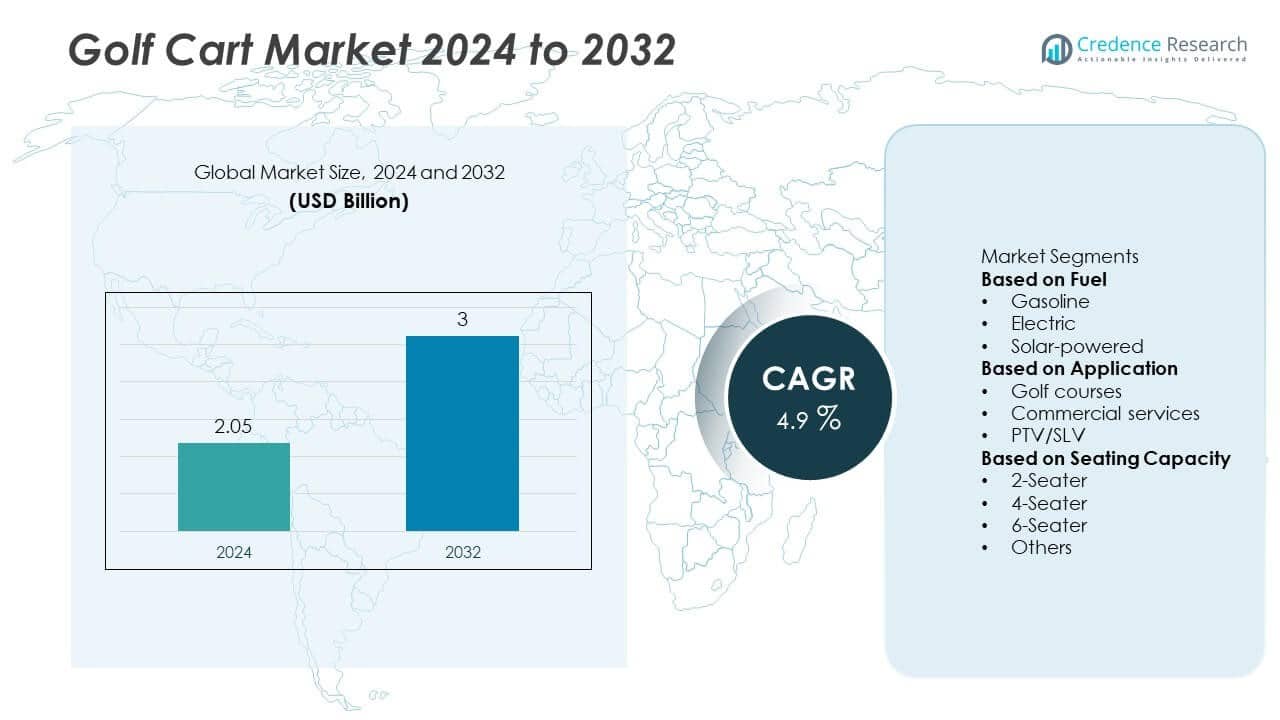CHAPTER NO. 1 : GENESIS OF THE MARKET
1.1 Market Prelude – Introduction & Scope
1.2 The Big Picture – Objectives & Vision
1.3 Strategic Edge – Unique Value Proposition
1.4 Stakeholder Compass – Key Beneficiaries
CHAPTER NO. 2 : EXECUTIVE LENS
2.1 Pulse of the Industry – Market Snapshot
2.2 Growth Arc – Revenue Projections (USD Million)
2.3. Premium Insights – Based on Primary Interviews
CHAPTER NO. 3 : GOLF CART MARKET FORCES & INDUSTRY PULSE
3.1 Foundations of Change – Market Overview
3.2 Catalysts of Expansion – Key Market Drivers
3.2.1 Momentum Boosters – Growth Triggers
3.2.2 Innovation Fuel – Disruptive Technologies
3.3 Headwinds & Crosswinds – Market Restraints
3.3.1 Regulatory Tides – Compliance Challenges
3.3.2 Economic Frictions – Inflationary Pressures
3.4 Untapped Horizons – Growth Potential & Opportunities
3.5 Strategic Navigation – Industry Frameworks
3.5.1 Market Equilibrium – Porter’s Five Forces
3.5.2 Ecosystem Dynamics – Value Chain Analysis
3.5.3 Macro Forces – PESTEL Breakdown
3.6 Price Trend Analysis
3.6.1 Regional Price Trend
3.6.2 Price Trend by Product
CHAPTER NO. 4 : KEY INVESTMENT EPICENTER
4.1 Regional Goldmines – High-Growth Geographies
4.2 Product Frontiers – Lucrative Product Categories
4.3 Application Sweet Spots – Emerging Demand Segments
CHAPTER NO. 5: REVENUE TRAJECTORY & WEALTH MAPPING
5.1 Momentum Metrics – Forecast & Growth Curves
5.2 Regional Revenue Footprint – Market Share Insights
5.3 Segmental Wealth Flow – Product, Application, & Seating Capacity Revenue
CHAPTER NO. 6 : TRADE & COMMERCE ANALYSIS
6.1. Import Analysis by Region
6.1.1. Global Golf Cart Market Import Volume By Region
6.2. Export Analysis by Region
6.2.1. Global Golf Cart Market Export Volume By Region
CHAPTER NO. 7 : COMPETITION ANALYSIS
7.1. Company Market Share Analysis
7.1.1. Global Golf Cart Market: Company Market Share
7.1. Global Golf Cart Market Company Volume Market Share
7.2. Global Golf Cart Market Company Revenue Market Share
7.3. Strategic Developments
7.3.1. Acquisitions & Mergers
7.3.2. New Product Launch
7.3.3. Regional Expansion
7.4. Competitive Dashboard
7.5. Company Assessment Metrics, 2024
CHAPTER NO. 8 : GOLF CART MARKET – BY PRODUCT SEGMENT ANALYSIS
8.1. Golf Cart Market Overview By Product Segment
8.1.1. Golf Cart Market Volume Share By Product
8.1.2. Golf Cart Market Revenue Share By Product
8.2. Electric Golf Carts
8.3. Gas Golf Carts
8.4. Pull Golf Carts
CHAPTER NO. 9 : GOLF CART MARKET – BY APPLICATION SEGMENT ANALYSIS
9.1. Golf Cart Market Overview By Application Segment
9.1.1. Golf Cart Market Volume Share By Application
9.1.2. Golf Cart Market Revenue Share By Application
9.2. Golfing
9.3. Utility work
9.4. Recreation
CHAPTER NO. 10 : GOLF CART MARKET – BY SEATING CAPACITY SEGMENT ANALYSIS
10.1. Golf Cart Market Overview By Seating Capacity Segment
10.1.1. Golf Cart Market Volume Share By Seating Capacity
10.1.2. Golf Cart Market Revenue Share By Seating Capacity
10.2. 2 Seater
10.3. 4 Seater
10.4. 6 Seater and Above
CHAPTER NO. 11 : GOLF CART MARKET – REGIONAL ANALYSIS
11.1. Golf Cart Market Overview By Region Segment
11.1.1. Global Golf Cart Market Volume Share By Region
11.1.2. Global Golf Cart Market Revenue Share By Region
11.1.3. Regions
11.1.4. Global Golf Cart Market Volume By Region
11.1.5. Global Golf Cart Market Revenue By Region
11.1.6. Product
11.1.7. Global Golf Cart Market Volume By Product
11.1.8. Global Golf Cart Market Revenue By Product
11.1.9. Application
11.1.10. Global Golf Cart Market Volume By Application
11.1.11. Global Golf Cart Market Revenue By Application
11.1.12. Seating Capacity
11.1.13. Global Golf Cart Market Volume By Seating Capacity
11.1.14. Global Golf Cart Market Revenue By Seating Capacity
CHAPTER NO. 12 : NORTH AMERICA GOLF CART MARKET – COUNTRY ANALYSIS
12.1. North America Golf Cart Market Overview By Country Segment
12.1.1. North America Golf Cart Market Volume Share By Region
12.1.2. North America Golf Cart Market Revenue Share By Region
12.2. North America
12.2.1. North America Golf Cart Market Volume By Country
12.2.2. North America Golf Cart Market Revenue By Country
12.2.3. Product
12.2.4. North America Golf Cart Market Volume By Product
12.2.5. North America Golf Cart Market Revenue By Product
12.2.6. Application
12.2.7. North America Golf Cart Market Volume By Application
12.2.8. North America Golf Cart Market Revenue By Application
12.2.9. Seating Capacity
12.2.10. North America Golf Cart Market Volume By Seating Capacity
12.2.11. North America Golf Cart Market Revenue By Seating Capacity
12.3. U.S.
12.4. Canada
12.5. Mexico
CHAPTER NO. 13 : EUROPE GOLF CART MARKET – COUNTRY ANALYSIS
13.1. Europe Golf Cart Market Overview By Country Segment
13.1.1. Europe Golf Cart Market Volume Share By Region
13.1.2. Europe Golf Cart Market Revenue Share By Region
13.2. Europe
13.2.1. Europe Golf Cart Market Volume By Country
13.2.2. Europe Golf Cart Market Revenue By Country
13.2.3. Product
13.2.4. Europe Golf Cart Market Volume By Product
13.2.5. Europe Golf Cart Market Revenue By Product
13.2.6. Application
13.2.7. Europe Golf Cart Market Volume By Application
13.2.8. Europe Golf Cart Market Revenue By Application
13.2.9. Seating Capacity
13.2.10. Europe Golf Cart Market Volume By Seating Capacity
13.2.11. Europe Golf Cart Market Revenue By Seating Capacity
13.3. UK
13.4. France
13.5. Germany
13.6. Italy
13.7. Spain
13.8. Russia
13.9. Rest of Europe
CHAPTER NO. 14 : ASIA PACIFIC GOLF CART MARKET – COUNTRY ANALYSIS
14.1. Asia Pacific Golf Cart Market Overview By Country Segment
14.1.1. Asia Pacific Golf Cart Market Volume Share By Region
14.1.2. Asia Pacific Golf Cart Market Revenue Share By Region
14.2. Asia Pacific
14.2.1. Asia Pacific Golf Cart Market Volume By Country
14.2.2. Asia Pacific Golf Cart Market Revenue By Country
14.2.3. Product
14.2.4. Asia Pacific Golf Cart Market Volume By Product
14.2.5. Asia Pacific Golf Cart Market Revenue By Product
14.2.6. Application
14.2.7. Asia Pacific Golf Cart Market Volume By Application
14.2.8. Asia Pacific Golf Cart Market Revenue By Application
14.2.9. Seating Capacity
14.2.10. Asia Pacific Golf Cart Market Volume By Seating Capacity
14.2.11. Asia Pacific Golf Cart Market Revenue By Seating Capacity
14.3. China
14.4. Japan
14.5. South Korea
14.6. India
14.7. Australia
14.8. Southeast Asia
14.9. Rest of Asia Pacific
CHAPTER NO. 15 : LATIN AMERICA GOLF CART MARKET – COUNTRY ANALYSIS








